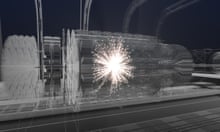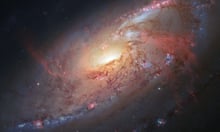Scientists at the Large Hadron Collider near Geneva have spotted an unusual signal in their data that may be the first hint of a new kind of physics.
The LHCb collaboration, one of four main teams at the LHC, analysed 10 years of data on how unstable particles called B mesons, created momentarily in the vast machine, decayed into more familiar matter such as electrons.
The mathematical framework that underpins scientists’ understanding of the subatomic world, known as the standard model of particle physics, firmly maintains that the particles should break down into products that include electrons at exactly the same rate as they do into products that include a heavier cousin of the electron, a particle called a muon.
But results released by Cern on Tuesday suggest that something unusual is happening. The B mesons are not decaying in the way the model says they should: instead of producing electrons and muons at the same rate, nature appears to favour the route that ends with electrons.
“We would expect this particle to decay into the final state containing electrons and the final state containing muons at the same rate as each other,” said Prof Chris Parkes, an experimental particle physicist at the University of Manchester and spokesperson for the LHCb collaboration. “What we have is an intriguing hint that maybe these two processes don’t happen at the same rate, but it’s not conclusive.”
In physics parlance, the result has a significance of 3.1 sigma, meaning the chance of it being a fluke is about one in 1,000. While that may sound convincing evidence, particle physicists tend not to claim a new discovery until a result reaches a significance of five sigma, where the chance of it being a statistical quirk are reduced to one in a few million.
“It’s an intriguing hint, but we have seen sigmas come and go before. It happens surprisingly frequently,” Parkes said.
The standard model of particle physics describes the particles and forces that govern the subatomic world. Constructed over the past half century, it defines how elementary particles called quarks build protons and neutrons inside atomic nuclei, and how these, usually combined with electrons, make up all known matter. The model also explains three of the four fundamental forces of nature: electromagnetism; the strong force, which holds atomic nuclei together; and the weak force which causes nuclear reactions in the sun.
But the standard model does not describe everything. It does not explain the fourth force, gravity, and perhaps more strikingly, says nothing about the 95% of the universe that physicists believe is not constructed from normal matter.
Much of the cosmos, they believe, consists of dark energy, a force that appears to be driving the expansion of the universe, and dark matter, a mysterious substance that seems to hold the cosmic web of matter in place like an invisible skeleton.
“If it turns out, with extra analysis of additional processes, that we were able to confirm this, it would be extremely exciting,” Parkes said. It would mean there is something wrong with the standard model and that we require something extra in our fundamental theory of particle physics to explain how this would happen.”
Despite the uncertainties over this particular result, Parkes said when combined with other results on B mesons, the case for something unusual happening became more convincing.
“I would say there is cautious excitement. We’re intrigued because not only is this result quite significant, it fits the pattern of some previous results from LHCb and other experiments worldwide,” he said.
Ben Allanach, a professor of theoretical physics at the University of Cambridge, agrees that taken together with other findings, the latest LHCb result is exciting. “I really think this will turn into something,” he said.
If the result turns out to be true, it could be explained by so-far hypothetical particles called Z primes or leptoquarks that bring new forces to bear on other particles.
“There could be a new quantum force that makes the B mesons break up into muons at the wrong rate. It’s sticking them together and stopping them decaying into muons at the rate we’d expect,” Allanach said. “This force could help explain the peculiar pattern of different matter particles’ masses.”
B mesons contain elementary particles called beauty quarks, also know as bottom quarks.
Scientists will collect more data from the LHC and other experiments around the world, such as Belle II in Japan, in the hope of confirming what is happening.









